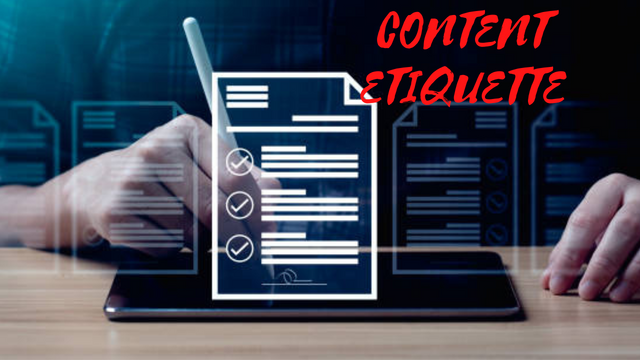.png)
PLAGIARISM EXPLAINED
Theft is the name given to the act of stealing things while plagiarism is the name given to the act of taking an idea, thought, language, document, and other intellectual works that are not yours without the acknowledgment nor the permission of the original owner. It pains to have another person get a reward, honor, and accolade for a work that belongs to you and it is deceptive to use what belongs to another to get or claim a reward from others. Plagiarism is the illegal and unapproved use of someone’s idea, thought, language, and any intellectual property whatsoever for personal use. When permission is not granted before the use of an individual’s original intellectual property is plagiarism.
Plagiarism is just like having another man claim a lady whose pride price is fully paid for. Or maybe it is like sowing on a piece of land and then having a stranger reap all your harvest. It pains!
STEEMIT ETIQUETTE

Content etiquette is the acknowledgment of the fact that contents cannot just be lifted without due permission or referencing. Content creators must be true creators; having the ability to create original content without attempting to steal someone else’s work or claim ownership of it. And knowing that when content is outsourced, making appropriate referencing or receiving proper permission before use is imperative. There are rules guiding the use of someone’s intellectual property and it is important for content creators to know and work with these rules as they go about their activities. Steemit as a platform that deals with content creation is not an exemption: all contents must be original with references well cited when outsourced. This is what steemit etiquette simply stands for.
TYPES OF PLAGIARISM AND WAYS TO AVOID THEM
.png)
NUMBER 1: DIRECT PLAGIARISM.
All kinds of plagiarism is bad but this kind is worst. This is the verbatim lifting of contents without spearing a word or language as the case may be. It is the wrong practice of directly copying and pasting a literary work without references or attributions.
HOW TO AVOID DIRECT PLAGIARISM
A. Decide not to copy and paste any work that is not yours.
B. Don’t be lazy! Be creative in producing your own work.
C. Read other people’s work only to gain understanding.
D. Properly reference or attribute where and when using a part (i.e, just a considerably small portion) of another person’s work is “extremely” necessary..
NUMBER 2: ACCIDENTAL PLAGIARISM.
<div class = "text-justify’> One cannot completely rule out the possibility to flow in the thought of another man most especially if you are fond of reading an author. Hence, an accidental kind of plagiarism may occur. In fact, it is possible that what you consider to be your own inspiration could be a deposit of what you have once read or heard therefore, accidental plagiarism can be made. At other times, it is accidental plagiarism when sources are not properly cited.
HOW TO AVOID ACCIDENTAL PLAGIARISM
A. You can use free plagiarism software checkers to check your works.
B. Be careful to make necessary attributions and citations
NUMBER 3: SELF PLAGIARISM
As the name implies, it is the intentional use and publication of one’s old or previous works as new. It is when an individual takes from his archive, an already published or submitted work and use it as new. The presentation of your previous original work as new is self plagiarism.
HOW TO AVOID SELF PLAGIARISM
A. Avoid the temptation of using your old works. Be honest and sincere to yourself by staying away from such practice.
B. Be creative and discipline in coming up with new works without looking at the old works.
NUMBER 4: PATCHWORK PLAGIARISM
This is the subtraction and addition of different works to make a whole. This type of plagiarism is achieved when an individual use different content relating to the same topic to produce his own content. Here, a person may take a sentence from one article and take three other sentences from another, and maybe a full paragraph from somewhere else. It is simply subtracting and mixing up contents to produce a complete work.
HOW TO AVOID PATCHWORK PLAGIARISM
A. Realise that it is wrong to be involved in this kind of act.
B. Develop the habit of learning people’s perspective rather than stealing their works. Read and understand different writers’ perspectives and that will help create your own perspective not mixing up different perspectives.
I am not ignorant of steemit etiquette rules having read all their rules and instructions on plagiarism.
EXAMPLE OF HOW TO CITE YOUR SOURCE.
According to this model, the speaker plays a key role in communication. He is the one who takes complete charge of the communication. The sender first prepares a content which he does by carefully putting his thoughts in words with an objective of influencing the listeners or the recipients, who would then respond in the sender’s desired way. No points in guessing that the content has to be very very impressive in this model for the audience or the receivers to get convinced. SOURCE
EXAMPLE OF HOW TO REFERENCE YOUR IMAGE.

HERE IS THE LINK TO MY SECOND (2ND) ACHIEVEMENT TASK: ACHIEVEMENT TASK 2: Basic security on steemit @tayon
hi @tayon
you need to wait for the verification process of the previous achievement before proceeding to the next achievement
Regards @heriadi
Downvoting a post can decrease pending rewards and make it less visible. Common reasons:
Submit
hello @tayon
if you are from #nigeria no need to add the #venezuala tag,
I hope you can provide examples of the use of image and text quotes in this achievement task
Downvoting a post can decrease pending rewards and make it less visible. Common reasons:
Submit